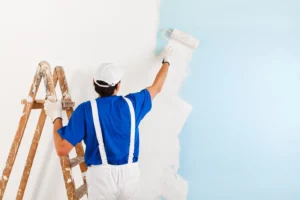Painters In Delaware your home interior is one of the most important home improvement projects you can do. It can dramatically increase the value of your home and make it look more beautiful.
Choosing the right paint is vital to ensure you get the best results. The type of paint you use will affect the color and finish and can also influence how long it takes to dry.

Texture painting is a popular interior residential technique that can create a unique look on your walls. The process involves using additives to the paint, which can give it a bumpy or gritty appearance. It is a great option for those who want to add some interest to their home without spending much money. However, it’s important to know what you’re getting into before you start this project. It’s also a good idea to do a test run before you apply it to your walls. The texture paint will most likely have instructions on the package regarding proportions and process, so be sure to read those carefully.
Some different types of textured paint are available on the market, and you can choose one that fits your style. For example, you can purchase a premixed textured paint that is ready for use and contains small, gravel-like particles. Another option is to buy paint and mix the texture ingredients, giving you more flexibility. There are also smooth textured paints that don’t contain any sand but are thicker and can give your walls the appearance of plaster or stucco.
When applying textured paint, being patient and working slowly is important. This is because the patterns can only be created while the paint is wet. Once it dries, the paint becomes much more difficult to manipulate. To make the most of your painting experience, working on a small area at a time is best.
Hiring a professional is a good idea if you’re new to painting. They’ll be able to help you find the right style for your home, and they’ll also be able to guide you through the process. In addition, a professional can make your walls look much better than you could do alone.
Before you begin, make sure the walls are clean and free of major blemishes. While textured paint can hide imperfections, it cannot disguise large holes or other damage.
Color blocking is a great way to bring energy into any space. In addition to brightening walls, it can highlight a room’s architectural features. The color-blocking technique can be used on walls, ceilings, cabinets, and fences! Using color blocking on these elements can give the room a dramatic look that will turn heads.
Colors that complement each other are best for color-blocking. It would be best to start by determining what colors are already present in your home and then select colors that work well with them. This will ensure that you create a harmonious design. It is also helpful to look at the color wheel to see what colors pair well. For example, blue and orange work well together. You can also use pastels with neons for a more unexpected look.
Another way to incorporate color-blocking into a space is by infusing it into a natural material. For example, you could paint an entire room boldly and then add wood accents to complement it. This will create a look that is both modern and rustic at the same time. This is a perfect solution for those who want to avoid a traditional look and still have a bold palette.
Often, you can find inspiration for color-blocking from contemporary art. It is believed that Piet Mondrian was the originator of this art movement, which he called Neo-Plasticism. His paintings featured simple squares and rectangles, influencing many other design styles. This trend has exploded into the fashion world and now appears on everything from t-shirts to furniture.
While most people think that only two colors are ideal for color-blocking, you can use as many. Some artists and color experts recommend using more than three colors to create an impactful look. This allows you to experiment with different hues and learn how they react under various light conditions.
One of the best things about this design technique is that it can be applied to any surface. For example, you can use it on a bedroom door, and no one will know it’s not the room’s original design. It’s a great way to define a reading nook in a playroom or to add contrast and definition to a dining area.
Painting a checkerboard pattern on your walls is an easy and stylish way to update your home. It’s also a great way to add a touch of nostalgia and personality to your living space. To get a perfect checkerboard design, it’s important to take your time and follow the proper steps. The first step is to prep the wall. Wash, patch, spackle, sand, and dry the surface before you start your project. You should also remove all outlet and light switch face plates and collect the screws in a zip-top bag for later.
Once you’ve prepped the wall, apply a base coat of the lighter color to the entire area. Then, use a pencil and a carpenter’s level to mark the squares you want to paint with the second color. Make sure the squares look equal and straight. You may need to do several rounds of measuring, marking, and taping to get them right.
Next, apply vertical strips of painter’s tape to the walls to create the block sections of your checkerboard pattern. Make sure the tape is positioned inside the squares you’ll be painting the second color so that only the edge of the box will be exposed to paint. If the squares aren’t even, you can measure and cut another strip of tape to create a new, evenly-sized square, then apply it to the wall.
Once the boxes are marked and taped, you can begin painting. Be careful not to go over the areas that will be the base color of your checkerboard, as this can cause the second color to bleed into the existing paint. When you finish painting, allow the paint to dry for at least 24 hours. After that, you can remove the tape and enjoy your finished checkerboard!
Letter stenciling is a fun way to add character and texture to your walls. It can be applied with a sponge or stenciling brush and used with any paint medium. Stencils are available in a wide range of sizes and fonts. You can also choose various colors, finishes, and textures to match your wall color or décor. If you’re new to stenciling, practicing first on cardboard or another surface is a good idea.
Whether you want to customize your home or want a unique accent wall, letter stenciling is an easy and affordable option. The key to success is choosing a simple design with straight lines and uncomplicated shapes. These designs are easier to cut out than curved edges and intricate details. You can draw the design by hand or use an image or photograph as a reference. Choose a high-resolution version to avoid distortion if you’re using a photograph.
To become a skilled artist, you can purchase pre-cut letter stencils for a quick and easy project. These stencils can be made from pliable, durable mylar or rigid, lightweight aluminum and can be custom-cut to any size and style. They can be used for one-time projects or produce many letters and designs simultaneously. Stencils can be purchased for a few dollars or less and are easy to clean.
These stencils can be used for various projects, including signs, graphic design, painting, and murals. They’re shatterproof and work with pencil, pen and ink, markers, and paint. They also come with spacers to help you keep the letters consistently spaced and aligned.
Whether you’re looking for an old-fashioned serif font or a flowing script, these letter stencils are ideal for any DIY project. They’re laser-cut for precision and are compatible with a wide variety of paints. They’re also reusable so that you can apply them again and again. They’re ideal for decorating your living room or bedroom and can even be used for labeling or up-cycling old furniture.
